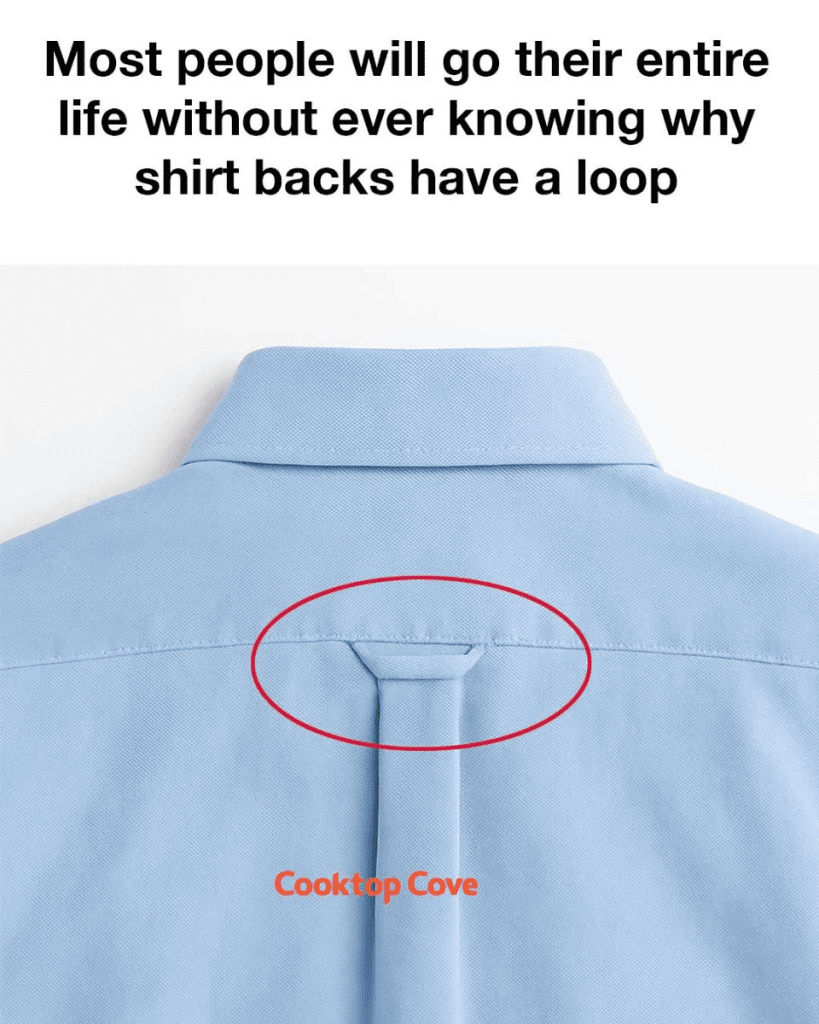We wear them, wash them, and hang them in our closets — but most people go their entire lives without ever realizing why some shirts have that small loop on the back. You’ve seen it, probably never thought twice about it. But here’s the twist: that tiny fabric tab is more than just a random design choice. It has a fascinating backstory rooted in practicality, tradition, and even romance.
Let’s pull back the curtain on this underrated fashion detail and explore why that little loop exists — and why it’s still showing up on modern shirts today.

The Locker Loop: A Clever Solution Born in the Ivy League
The back loop, also known as the locker loop, made its first big appearance in the 1960s thanks to GANT, an American brand catering to Ivy League college students. Picture dorm life in those days — cramped rooms, crowded gyms, and shared lockers. Not everyone had space (or a hanger) to neatly store their clothes.
So what did GANT do? They stitched a small loop onto the back of their dress shirts, allowing students to hang their shirts directly from a locker hook — no hanger needed. It was simple, effective, and instantly practical.
And just like that, the locker loop became a hit — blending function with fashion in one smart stitch.
Video: Why do button-down shirts have that little loop on the back?
It’s Not Just for Lockers: The Loop’s Multi-Tasking Magic
While its original purpose was locker storage, the loop’s usefulness didn’t stop there. Over time, it became a versatile little add-on that solved other daily wardrobe problems. Let’s look at what else it’s good for.
A Handy Trick for Air-Drying Your Shirts
Ever hang a wet shirt on a hanger only to find those dreaded shoulder bumps afterward? The back loop solves that. Hang the shirt by the loop and let gravity do its thing — no warping, no creases, and no weird bulges at the shoulders.
It’s a gentle way to air-dry without damaging the shape of your shirt. Think of it as the shirt’s built-in drying handle.

A Silent Nod to Style and Tradition
Even though most of us aren’t hanging shirts in lockers anymore, the loop stuck around. Why? Because it became a subtle style statement.
Shirts with back loops now evoke a sense of preppy, timeless fashion — think Ivy League charm, classic menswear, and vintage vibes. Designers started playing with the loop, adding different colors, patterns, and placements. In a world obsessed with minimalism and clean lines, that tiny loop suddenly added a whisper of character to otherwise standard dress shirts.
Wait, It Was Also a Dating Signal?
Believe it or not, back in the day, the shirt loop played a small role in college romance. There was a quirky tradition: if a guy was in a relationship, he’d cut off the loop on his shirt to show he was taken.
Think of it like a subtle fashion version of Facebook’s “In a Relationship” status — but way more analog.
And yes, some girls would even wear the guy’s loop on a chain or bracelet like a trophy. Fashion meets flirting. Who knew?
Video: Why Your Shirts Have Loop On Back?
A Marker of Quality and Detail-Oriented Craftsmanship
Here’s another way to think about it — when a shirt has a back loop, it’s often a sign the manufacturer pays attention to the little things. Brands that add a loop tend to care about design, function, and tradition. They aren’t just pumping out basic garments — they’re curating thoughtful details.
That loop is like a wink from the designer, a nod to heritage and a respect for craftsmanship.
Modern Takes: From Statement to Staple
Fashion designers today still include the loop, but now they’re playing with it. Some loops are made oversized and decorative. Others are stitched in leather or accented with contrasting thread. Occasionally, loops even show up on casual t-shirts or outerwear — a playful throwback to the tradition.
You may not need it to hang your shirt anymore, but it still earns its place in design — proving that the old-school features can still be stylish today.

So Why Do We Keep the Loop Around?
The better question is — why not?
It’s functional, nostalgic, and oddly iconic. It reminds us of a time when design was simple but purposeful. When every feature, even the smallest one, served a reason. And honestly, it’s kind of cool to have a fashion feature that most people overlook… until they hear the story behind it.
It’s like a secret handshake for people who love clothes with character.
Conclusion: A Tiny Loop with a Big Story
That small loop on the back of your shirt isn’t just a leftover piece of fabric — it’s a story stitched into your clothes. It’s a piece of college history, a drying trick, a fashion signature, and even a dating signal all rolled into one.
So the next time you button up your dress shirt and notice that loop, smile. You’re wearing more than a shirt — you’re wearing a little piece of fashion history that quietly connects the past to the present.